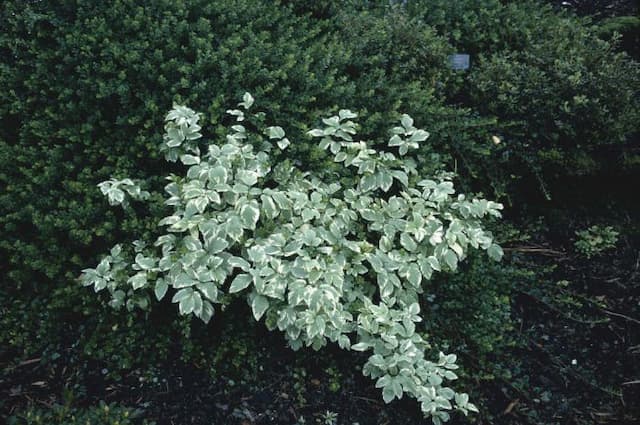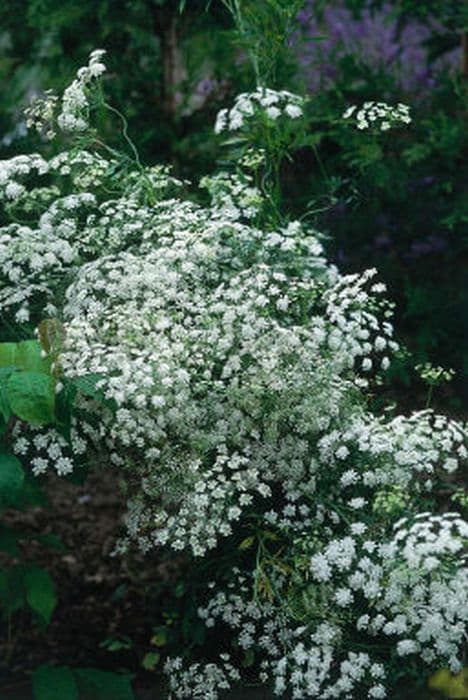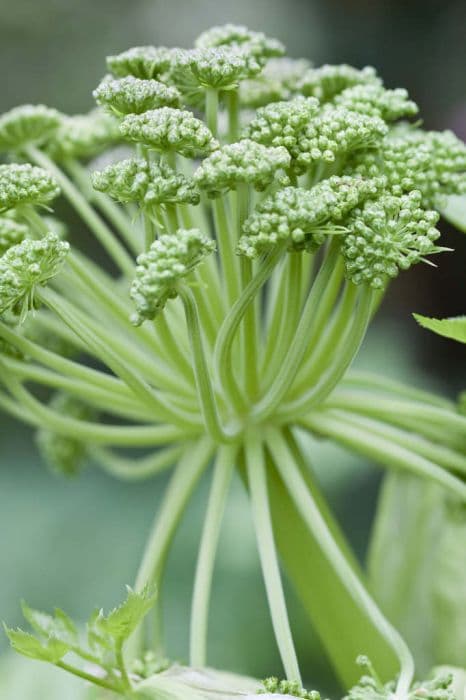White Lace Flower Orlaya grandiflora

ABOUT
Orlaya grandiflora, commonly known as white laceflower, is a charming flowering plant with a delicate and airy appearance. The plant is known for its exquisite, flat-topped clusters of tiny flowers that together create a lacy, umbrella-like canopy. Each of the small flowers is pristine white with a prominent cluster of dark stamens that provide a striking contrast, giving it an ornate and detailed look. The petals surrounding the central florets are typically larger, which further enhances its intricate appearance. The foliage of the white laceflower is finely divided, resembling delicate green lace, with leaves that are finely cut and feather-like, adding to the plant's overall graceful and ferny texture. The branches often spread out, creating a soft, mounded shape that complements the gentle characteristics of the flowers. The combination of its lacy leaves and sumptuous flower clusters gives the white laceflower a dainty and elegant presence in any garden setting, making it a popular choice among gardeners and flower enthusiasts for adding a touch of refinement and subtle beauty.
About this plant
 Names
NamesFamily
Apiaceae
Synonyms
White Lace Flower, Large-flowered Orlaya, Minoan Lace
Common names
Caucalis grandiflora, Daucus grandiflorus, Myrrhis grandiflora.
 Toxicity
ToxicityTo humans
Orlaya grandiflora, commonly known as white laceflower, is not known to be toxic to humans. There are no well-documented cases of poisoning or adverse effects from ingesting any part of this plant. However, as with any plant, individual allergies and sensitivities can exist, and it is generally recommended to avoid eating plants that are not typically classified as edible.
To pets
White laceflower is not known to be toxic to pets. There is no significant data suggesting that Orlaya grandiflora would cause poisoning in animals if ingested. Nonetheless, pet owners should always exercise caution and prevent pets from consuming plants that are not intended as food, as individual animals may have unpredictable reactions or sensitivities.
 Characteristics
CharacteristicsLife cycle
Annuals
Foliage type
Deciduous
Color of leaves
Green
Flower color
White
Height
1-2 feet (30-60 cm)
Spread
1-2 feet (30-60 cm)
Plant type
Herb
Hardiness zones
2-11
Native area
Mediterranean
Benefits
 General Benefits
General Benefits- Aesthetic Appeal: Orlaya grandiflora, commonly known as White Laceflower, adds beauty to gardens with its delicate white flowers and lacy foliage.
- Attracts Pollinators: The flowers of the White Laceflower attract bees, butterflies, and other important pollinators to the garden, aiding in plant reproduction and biodiversity.
- Companion Planting: White Laceflower can be planted alongside vegetables and other flowers to create a diverse garden ecosystem, potentially improving plant health and yields.
- Easy to Grow: It is a hardy plant that is relatively easy to cultivate, making it suitable for novice gardeners or those looking for low-maintenance garden additions.
- Self-Seeding: White Laceflower is capable of self-seeding, which means it can naturally reproduce and continue growing in the garden year after year without much intervention.
- Edible Flowers: The flowers of the White Laceflower are edible and can be used to add a decorative touch to salads and desserts.
 Medical Properties
Medical PropertiesThis plant is not used for medical purposes.
 Air-purifying Qualities
Air-purifying QualitiesThis plant is not specifically known for air purifying qualities.
 Other Uses
Other Uses- Orlaya grandiflora, commonly known as White Laceflower, can be used in dried flower arrangements. Its delicate umbels retain their shape and add a distinct texture to compositions.
- The White Laceflower is sometimes used in crafts, particularly in the creation of natural, botanical art pieces where the fine, lace-like flowers add elegance and intricacy.
- The seeds of the White Laceflower can be included in seed mixes for wildflower gardens, supporting biodiversity and attracting beneficial insects.
- In cottage gardens, White Laceflower serves as a companion plant, fitting in with a variety of other flowers and creating a full, abundant look.
- In eco-friendly garden practices, White Laceflower can be used for natural pest control, as it attracts predators of harmful insects.
- White Laceflower is utilized in landscape photography, providing a delicate foreground interest or as part of a picturesque meadow scene.
- The plant is used in educational settings, such as botanical studies, to demonstrate the structure of Apiaceae (the carrot or parsley family) inflorescences.
- White Laceflower can be part of sensory gardens, where its textured flowers can be appreciated by touch, especially for those with visual impairments.
- Gardeners may choose to plant White Laceflower as a border plant due to its impressive height and striking flower heads that can delineate spaces within the garden design.
- During certain festivals or events celebrating nature and spring, the White Laceflower is included in floral displays and natural decor due to its white, lacy appearance that symbolizes freshness and new beginnings.
Interesting Facts
 Feng Shui
Feng ShuiOrlaya grandiflora, commonly known as white laceflower, is not used in Feng Shui practice.
 Zodiac Sign Compitability
Zodiac Sign CompitabilityWhite laceflower is not used in astrology practice.
 Plant Symbolism
Plant Symbolism- Purity: The white color of the "White Lace Flower" often symbolizes purity and innocence, similar to other white-flowered plants.
- Elegance: Its delicate, lace-like flowers convey a sense of finesse and refined beauty, representing sophistication and elegance.
- Connection: The intricate network of the flower's tiny blossoms can represent the interconnectedness of life or social ties.
- Charm: The ornamental quality of the Orlaya grandiflora makes it a symbol of charm and attractiveness.
 Water
WaterWhite laceflower, or Orlaya grandiflora, prefers consistent moisture, especially during its growing season in spring and summer. It should be watered deeply once a week, allowing the soil to dry slightly between waterings. Depending on the climate and weather conditions, this typically translates to about one inch of water weekly. It's important to avoid overwatering and ensure good drainage to prevent root rot. During hot, dry spells, you may need to water more frequently, but always check the soil moisture first.
 Light
LightWhite laceflower thrives in full sun to partial shade. The plant will perform best when placed in a location that receives at least six hours of direct sunlight each day. However, it can also tolerate some afternoon shade, especially in hotter climates to protect it from intense heat.
 Temperature
TemperatureWhite laceflower can tolerate a wide range of temperatures but prefers to grow in conditions between 60°F and 75°F. It will typically survive minimum temperatures down to about 20°F. Ideally, the night temperature should not drop below 40°F for optimal growth.
 Pruning
PruningWhite laceflower should be pruned to remove spent flowers and encourage a second bloom. Deadheading, or the removal of faded blooms, should be done regularly throughout the flowering season. Light pruning can also be done in early spring to shape the plant and promote bushier growth.
 Cleaning
CleaningAs needed
 Soil
SoilWhite laceflower (Orlaya grandiflora) thrives best in a well-draining soil mix, with a pH ranging from 6.0 to 7.5. A mixture containing equal parts of loam, peat, and sharp sand or perlite would provide the right structure and nutrients. Regular amendment with organic matter like compost helps maintain soil fertility.
 Repotting
RepottingWhite laceflower generally doesn't require frequent repotting and can often thrive in the same pot for several years. Check the root system annually, and only repot when the plant becomes root-bound, which may typically be every 2-3 years.
 Humidity & Misting
Humidity & MistingWhite laceflower prefers average to low humidity conditions and will do well in the typical humidity levels found in most homes, making it an easy-care choice for indoor growers.
 Suitable locations
Suitable locationsIndoor
Provide bright light and well-drained soil for growing white laceflower indoors.
Outdoor
Plant in full sun to part shade with good soil drainage for white laceflower.
Hardiness zone
2-8 USDA
 Life cycle
Life cycleOrlaya grandiflora, commonly known as white laceflower, begins its life cycle as a seed, which germinates in early spring under suitable temperature and moisture conditions. Upon germination, the seedling emerges, developing a rosette of deeply cut basal leaves and establishing a root system. As the plant matures, it develops a tall, branching stem with more finely divided, feathery leaves, eventually leading to the flowering stage in late spring or early summer. The white laceflower produces large, flat umbels of small white flowers with a lacy appearance, which are attractive to a variety of pollinators. Following pollination, the plant sets seed in the form of small, dry fruit known as schizocarps, which disperse to propagate the next generation. The plant completes its life cycle with senescence after setting seed, dying back to the ground after one season as it is an annual species.
 Propogation
PropogationPropogation time
Spring to Summer
Orlaya grandiflora, commonly known as white laceflower, is most effectively propagated through seed. The best time to sow its seeds is in early spring as soon as the soil can be worked. After lightly pressing the seeds into the soil, cover them with a thin layer of soil, about 1/8 inch (approximately 3 mm) deep. White laceflower seeds prefer cooler conditions for germination, so the early spring sowing aligns with their natural growth cycle. Water the area gently and keep it consistently moist until germination, which typically occurs within 14 to 21 days. Thinning seedlings to around 8 to 12 inches (20 to 30 cm) apart will provide adequate space for mature plants. This simple and direct sowing method is what makes white laceflower an easy and rewarding plant for gardeners, allowing them to aerate beds and add an elegant touch to their garden with minimal effort.









